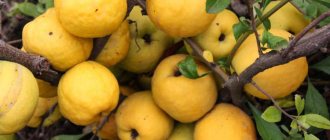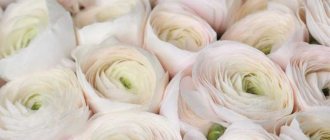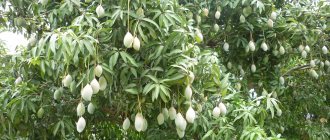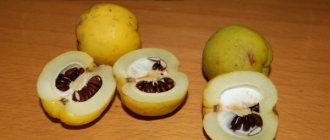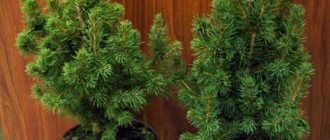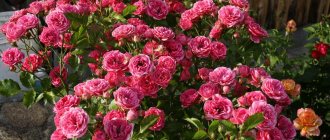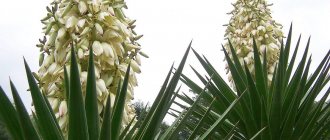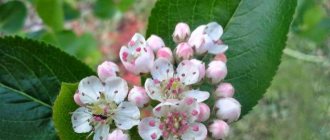Growing Japanese quince at home is not difficult. The main thing is to choose planting material, feed the substrate for planting and plant the exotic plant. The culture differs from others in its bright flowering, unique design and special resistance to pests. It is because of these qualities that gardeners grow it in their summer cottages. Unusual, beautiful fruits attract the eye. If you follow all the rules for care, regular feeding and watering, quince will please the owner with a good harvest.
Plant characteristics
The culture appeared in 1874. Bush Chinese or Japanese quince is endowed with many beneficial properties. Leaves and fruits are used in folk medicine for the treatment and prevention of various diseases. The plant is widespread throughout China and Europe, but the shrub is native to Japan. Another name, Chaenomeles, literally translates as “split the apple.”
The Japanese quince bush has expressive and beautiful orange flowers, loves warmth and grows especially well in regions with a mild climate. The plant tolerates temperatures below –30 degrees, so it is grown throughout the country. When picking in the north of Russia, freezing of flower buds and shoots is possible, which causes less lush flowering of the bush.
Under favorable conditions, the Chaenomeles tree in open ground grows up to three meters high and has a crown of the same diameter. The leaves are ovoid (oval) in shape, up to 5 cm long and up to 3 cm wide. In the early stages they have a bronze color, later they take on a dark green color. The orange or pink flowers grow up to 5 cm. The fruits are edible and ripen towards the end of autumn, reaching 6 cm.
Varieties of Japanese quince
The plant has a large number of varieties. The most popular and frequently encountered ones are highlighted:
- Nikolai is a short, soft variety, bred by Ukrainians, has a spreading crown, flowers are orange-red in color, fruits weigh about 60-80 grams with a slightly lumpy yellow appearance.
- Gayvardi - salmon-orange flowers, most often used for decorative decoration.
- Malardi - has beautiful pink petals, decorated with a white border on the sides, mainly used for decorative purposes.
- Likhtar - a variety bred in Ukraine, reaches a height of 1 meter, is characterized by increased resistance to cold, diseases, pests and tolerates winter more painlessly. It is not thorny, has red-orange petals and round, almost non-lumpy fruits weighing more than 80 grams.
- Papella is another decorative quince with an unusual color: yellow flowers with a pink frame.
- Fascination is a variety bred in Holland, up to 1 meter high, branches filled with thorns and large red flowers, fruits are ovoid or round in shape and green, weighing up to 50-60 grams.
- Merlozi - a species obtained by the Belgians, has spiny branches and grows up to 2 meters high, large white flowers with pink stripes, pear-shaped fruits weighing more than 50 grams.
- Umbilicata is a Japanese, tall (up to 2 meters) variety, has spiny straight branches, pink-red flowers and fruits weighing up to 80 grams.
Crimson End Gold is a variety bred in America, with spreading and prickly branches, medium height (up to 1 meter) and dark red flowers. The fruits are yellow-green in color and weigh up to 40-80 grams.
Simoni is a low variety of French selection (1-1.5 meters high), with large, dark red petals and spreading prickly branches. The fruits weigh up to 80 grams, are ovoid in shape, and greenish-yellow in color.
Nivali is another French tall variety, up to 2 meters high. With spiny, densely arranged branches and white, medium-sized flowers, the fruits are yellow, grow and weigh up to 90 grams.
The list is quite impressive. And this despite the fact that these are not all possible varieties, but only a minority of the most popular types.
Using Japanese quince in landscape design
Chaenomeles can rightfully be considered one of the most beautiful shrubs: leaves are brightly colored, red, orange, pink, which shimmer in the sunlight. Vibrant green leaf color. Unusual yellow-orange or yellow-green fruits, reminiscent of apples or pears. The most important advantage of this plant is that it remains attractive from early spring until late autumn.
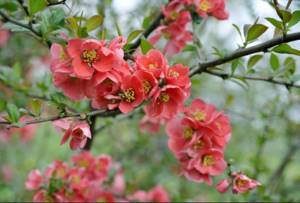
The lifespan of a flower is several decades. This means that Japanese quince planted in the garden will become a wonderful decoration and will delight for many decades. High varieties are not always used for landscapes. Low-growing species with a height of no more than 1 meter can be very attractive if used correctly. Chaenomeles is often used to create hedges, original, geometric or creative compositions. The tree goes well with daffodil, bluebells, thuja and dwarf spruce.
The best “neighbors” of a tree
Quince occupies a special place in the garden, if only because it needs a lot of free space around it. A not too large tree with a crown of about two meters in diameter grows roots that cover an area with a diameter of 6 - 8 meters. Any plants planted nearby will take away nutrients from the quince, which will immediately affect the quality and size of the crop. Therefore, it is planted no closer than 5 meters to other trees, and empty soil remains underneath it so that other plants, even if they are not afraid to grow in the shade, do not disturb the quince roots located close to the surface.
The heat-loving crop needs a lot of sunlight, so there should be no buildings or tall trees nearby that would shade it. They find an open place for the quince, a southern slope would be suitable, and if there were some other protection from the cold north wind, this would be an ideal place. In winter, you need to install shields to retain snow; the larger the snowdrift around the tree, the better it will withstand frost.

Sometimes a hedge is made from quince, planting plants at a distance of one and a half meters from each other. Such crowding creates not very comfortable conditions, but there is an opinion that it is in such dense plantings that trees produce the most useful fruits, although they will not be too large.
Quince is a non-self-fertile crop, which means that to obtain a harvest it requires cross-pollination of flowers of different varieties. Modern varieties are not only resistant to frost and diseases, they are also declared by breeders to be self-fertile. But the harvest will undoubtedly be better if a different variety of quince grows on the same plot (or on a neighboring one); such a neighbor will be the most desirable. If this does not work out, then you need to graft a branch of a different variety onto the tree. It can be grafted onto a pear rather than a quince; these related crops become an excellent rootstock for each other. The proximity of pears and apples, contrary to the wishes of many gardeners, is not a salvation for non-self-fertile quince varieties.
When to plant a plant
The most favorable time for planting quince in the ground is March. During this period, sap flow begins. Later planting is also possible, for example, in autumn. But this sometimes becomes the reason that the plant does not take root until the weather changes and frosts occur. The most suitable specimens for planting are two-year-old Chaenomeles seedlings, which must be watered abundantly before picking.
It is preferable to use seedlings with roots. Otherwise, you need to carefully examine them and, if necessary, soak them in water, then remove any rotten or dried areas.
Quince is very photophilous and it is advisable to place it in a sufficiently illuminated area, since low lighting has a negative effect on flowering. Therefore, you should choose an area with a sunnier part of the house or make a pick in a place protected from winds and frost. Caring for quince and planting it do not differ from the general rules for growing shrubs in the garden.
Preparing the soil for planting
For picking in the spring, the soil must be prepared in the fall. It is necessary to completely exterminate weeds under black fallow. If necessary, it is recommended to add sheet soil and sand to the soil. The use of peat manure compost in a volume of 10 kilograms per square meter and potash fertilizers of 40 grams will help. Quince loves podzolic, light, humus-rich soil. On peat soil it takes root a little worse.
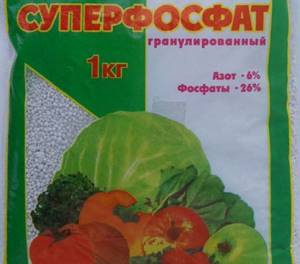
It is advisable to choose a place sheltered from the wind. After selecting and preparing the site, dig a hole 50-80 cm deep and 50-60 cm in diameter with the addition of soil mixture. To prepare the substrate you will need:
- a couple of buckets of humus;
- 400-600 grams of ash;
- 150-300 grams of superphosphate;
- 30-40 grams of potassium nitrate.
When transplanting in groups, it is necessary to place the plants at a distance of 100–150 cm from each other. If you plan to make a living fence out of trees, then pick specimens every 50 cm. If the goal is to obtain a harvest, then place several different varieties (2-3 species) nearby. One Chaenomeles bush produces up to 2 kg of fruit, and in especially fruitful years up to 5 kg.
Immediately before planting, you should pour a mound of soil mixture into the hole and place the seedling on it so that the root collar and the surface of the ground are at the same level.
It is recommended to fill the remaining space around with the prepared mixture. After this, compact and water abundantly, and shorten the shoots to 20 cm. An important condition that must be observed when planting is that the quince root should not be exposed and the neck should not be deepened, as this will slow down the growth rate. After planting, the plant should not be disturbed, since quince does not survive picking and moving from one place to another.

In one area the shrub will grow for up to 60 years. Caring for the planted quince and its cultivation will not be difficult. During the first periods it is necessary to water regularly, especially generously in dry weather. After moistening, you need to loosen the soil to a depth of 10 cm, remove all weeds to preserve moisture in the soil.
Fertilizer at the time of picking will last for a year. For the second season, it is necessary to add mineral and organic fertilizers to the feeding substrate, one bucket of compost, superphosphate - 400 grams, potassium fertilizer - 100 grams to the tree trunk area of the bushes.
If desired, during the summer it will be useful to feed liquid saltpeter at a rate of 30 grams per bush and mullein at a rate of 2-3 liters. Before the change of season and the onset of winter, the plant needs additional preparation. The area around the trunk circle is tightly covered with foliage; you can use purple spruce branches. Low bushes should be covered with boxes or crates.
Planting Japanese quince

Conditions for growing quince
When choosing a place to plant quince on a site, pay attention to the peculiarities of the agricultural technology of this crop.
- Quince lighting.
The plant loves sunlight very much; moreover, quince leaves and flowers are not afraid of direct sunlight. Therefore, the crop can be planted directly in open areas. Placing quince in shaded areas will not cause disease or death, but will significantly affect the splendor and effectiveness of flowering, and fruiting will be reduced or stopped altogether. - Air temperature for quince.
As already mentioned, the frost resistance of quince depends on the chosen variety. But with above-zero temperatures everything is simpler: quince tolerates heat well. - Air humidity for quince.
Quince is a more drought-resistant plant; it does not suffer from reduced watering and does not require spraying, although in hot weather, of course, the crop requires watering. However, watch the amount of water; stagnant moisture is more dangerous for the crop than lack.

Step-by-step instructions for planting Japanese quince are as follows:
- Choose the right time to plant quince. Gardeners recommend planting quince in the spring; in this case, you can be sure that the shrub will have time to take root before winter. But if you live in the southern regions, autumn planting of quince is also available to you.
- Choose the right quince seedlings. Seedlings two years old take root easily and quickly begin to grow.
- Properly prepare the place for planting quince. Each seedling needs a planting hole up to 0.8 m deep. The soil for quince should consist of leaf soil, peat and sand; add fertilizer to the soil in the form of potassium nitrate, superphosphate, ash and humus.
- Plant the quince correctly. You should not deepen the root collar, nor should you raise it too much above the surface of the earth. Place shrubs in groups; quince does not grow well alone. But don’t be too quick with planting: in order for an adult plant to be comfortable, the step between planting holes should be 1 m.

Caring for quince is not difficult; you need to follow a number of sequential procedures.
- Watering quince.
The peculiarity of the quince root system is the length of the root shoots; they can reach 5 m, thanks to which they cope well with the extraction of groundwater for nutrition. To roughly understand what moderate watering of quince means, remember this frequency: water young seedlings once every 3 weeks, adult shrubs - once every 2 months. - Quince pruning.
Sanitary pruning of quince in the spring is practiced, and formative pruning of quince is also necessary to avoid thickening of the branches and disease of the bush. Carry out the procedures only in the spring; autumn pruning increases the risk of death from frost.

- Feeding quince.
Quince loves organic and mineral fertilizers, however, it is important to properly feed it. The first year after planting, applying fertilizers to the soil can do more harm than good; the crop has enough nutrients added during planting. Starting from the second year, start feeding the plant with the same set of fertilizers that you needed a year ago (mineral fertilizers in the form of superphosphate and potassium, organic matter - compost). Apply fertilizers to the tree trunk soil; there is no need to dig.

- Wintering quince.
Non-frost-resistant varieties are available for planting only in the southern regions; those varieties that are able to withstand sub-zero temperatures also need help. Build a shelter for the quince during frost from spruce branches or a cardboard box. It is important to protect the plant from the wind and throw as thick a layer of snow on top as possible. - Quince transplant.
The culture does not tolerate changing places very well, so it is better not to do this unless absolutely necessary. If there is no other way out, carry the quince with a lump of earth, water it after transplanting, and try not to disturb it. - Quince diseases.
The culture is quite resistant to various diseases and pest attacks, however, if trouble does occur, quince can be easily cured by spraying with a solution of copper sulfate.
Pruning a fruiting tree
There will be no problems with pruning quince. The plant tolerates such procedures well; this feature is a huge plus for gardeners involved in ornamental propagation. As a safety precaution, it is a good idea to wear gloves when pruning to avoid cuts. In the spring, the bushes are cleaned for sanitary purposes, dry, frozen, damaged, and improperly growing branches and shoots are cut off.

Before sap flow begins, formative pruning is carried out. But it is better to do this at 4-5 years of age, so that the quince does not grow wider and thicken. A certain part of the shoots is cut out annually and no more than 3-4 young offspring are left. Shoots located horizontally at a height of 35-50 cm from the ground are considered the most valuable, while the vertical parts should be removed.
The so-called anti-aging pruning is also used, which is done when the shrub reaches the age of eight to ten years. The growth of shoots will decrease annually to 10-15 cm per year. The procedure is easy. You need to thin out the bush and leave about 15 good, strong shoots. Basically, the fruits grow on four to five year old branches, so old areas must be periodically removed, they will be replaced by young shoots.
Planting in autumn
If the quince is supposed to be planted in the fall, and this will be September - October, then it is advisable to prepare the site in the spring, but it is permissible to dig it up, clear it of grass and roots, apply fertilizer, and water it in July - August. The soil must stand for at least a month, especially if not only fertilizers were applied, but the soil structure was corrected.
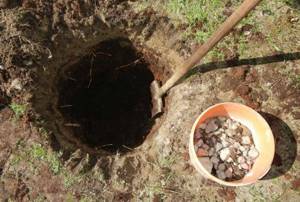
Immediately before planting, they dig a hole 40–50 cm deep and 60–100 cm in diameter. The quince root system develops in width; the roots do not grow deeper than one meter, but their diameter can be several times greater than the width of the crown, which is why such a large place is being prepared. The diameter of the hole for the seedling should be 10–20 cm larger than the existing root system.
Lay clay at the bottom of the pit, then earth mixed with humus (or compost), superphosphate and wood ash. This composition should occupy at least one third of the pit; ordinary garden soil is poured on top. The roots of the seedling are placed on the ground and carefully covered, lightly compacted, trying to ensure the greatest possible contact of the soil with the roots, but not to damage them. The grafting site should be about three centimeters underground. Having completely filled the hole, they compact the earth around the trunk, water it, and mulch it. For watering you will need at least two buckets of water. Since this is happening in the fall, with gradual cooling ahead, you can immediately lay a thick layer of mulch - at least 10 cm. For mulch, use peat or compost. Mulch the entire area of the ground above the roots and a little more to protect them from future frost, and not just retain moisture.

After autumn planting, the branches are pruned only if there are broken ones; the main pruning will be done later, when the tree survives its first winter.
How to properly increase quince
At home, you can get a new plant using several methods:
- with the help of the offspring;
- when planting prepared seeds;
- cuttings;
- vaccination.
Reproduction by root suckers
The quince bush is constantly expanding due to its abundant root system. By its twentieth anniversary, it occupies an area of up to 2 square meters. It is possible to dig it up and transplant root shoots 15 cm long and 5 mm wide.

One bush produces up to 6-7 such offspring with well-developed roots. Replanted areas must be watered and the soil surface mulched with shavings or humus. This type of reproduction has one drawback. This is the insufficient development of root shoots in comparison with the mother bush, which forces them to carry them to term.
Propagation by seeds
One of the most reliable methods. Before winter, fresh planting material is planted in the substrate, and in the spring they produce the first sprouts and seedlings. Seedlings should be transferred to a permanent location as early as possible. Specimens that are about 2 years old form lilac roots. In the event that the planting material was not sown in time, it is stored until winter. You can put it in the refrigerator with a bag, inside of which it is recommended to put wet sand, and keep it like that for two to three months. In April they are sown in the soil.
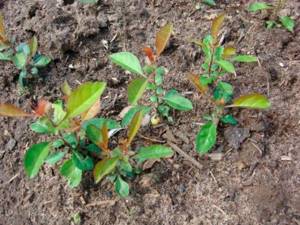
Propagation by cuttings
This method preserves all the nuances of the varietal appearance, which is an advantage. Good weather is chosen for cutting planting material. Usually the procedure is carried out in early June and specimens are taken that have one or two buds on each shoot. For better rooting, use growth stimulants - Kornevin or butyric acid.
The cuttings must be placed in a special mixture consisting of three parts sand and one part peat, at an angle of 45 degrees and kept under a transparent lid (cap) at a temperature of at least +20-25 degrees. After 30-40 days, the roots will sprout, after which they can be planted in the place where they will permanently reside.
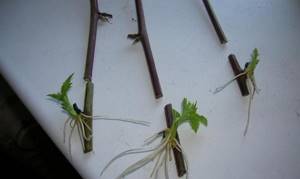
Reproduction by grafting
The plant undergoes this procedure in May using the so-called improved copulation. A cutting of the required variety is taken as a sample. They are vaccinated in July-August, as sap flow occurs during this period.
From the middle part of the shoot, cut off an eye (bud) with a small piece of bark and make a T-shaped incision in the scion area. Next, bend the bark and insert a piece of bark with an eye under it. The folded edges of the cut are pressed tightly and tied. When carrying out the procedure, it is important that the peephole itself is not covered with a bandage. If the sequence is followed correctly, everything will take root in a month. The material is removed in the spring of next year if the installed bud sprouts.
2. Quince - planting and care
2.1.Growing, pruning
When growing quince in open ground, as well as if you take the plant outside in the summer, it is necessary to provide protection from the wind. With the help of pruning, the tree is formed - the quince can be kept compact and at the same time get rid of old, diseased and dead shoots.
↑ Up,

↑ Up,

2.2. Quince propagation
Growing from seeds at home is quite troublesome. Quince seeds are sown in a cold greenhouse in February. Seeds require 18 weeks of cool stratification before planting if they are fresh, while old ones will need 2 weeks of warm stratification followed by 18 weeks of cold stratification. They are planted in a permanent location in late spring or early summer, after the last expected frost. It is also propagated vegetatively by mature cuttings in a cold greenhouse.
↑ Up,

2.3.When it blooms
Flowering occurs in late spring for about three weeks, when spring frosts are not dangerous. Flowering quince is very attractive.
2.4.Transplanting quince
Planting in fresh soil and a larger pot is carried out in the spring, as it grows or if it is necessary to replace the substrate. For large tub plants, the top layer of soil is replaced with fresh one every year.
↑ Up,

2.5.Diseases and pests
Quince is very prone to bacterial diseases; sometimes they rot if the soil moisture is too high.
Among the pests, scale insects, mites, and aphids pose a certain danger. When grown in open ground, codling moths, cherry flies, leaf miners, and sawflies may appear.
2.6.Containment temperature
In spring and summer, temperatures ranging from 18 to 24° C are suitable for cultivation. Plants are frost-hardy around -15° C, although the fruit rarely ripens in cool conditions.
↑ Up,
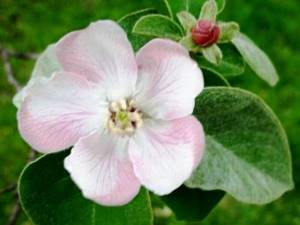
2.7.Feeding quince
During the period of active growth, apply mineral fertilizers every 2 weeks.
↑ Up,
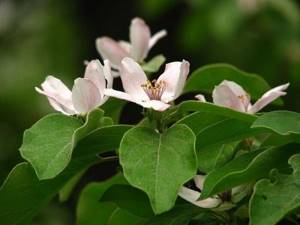
2.8.Lighting
Quince can grow in full shade, partial shade or in a sunny location. Partial shade also negatively affects the quality of the fruit.
↑ Up,

2.9.Soil for quince
Prefers light, moist, rich, well-drained soil. Suitable for sandy, medium loamy and clayey soils. Soils with pH 6 - 7.
2.10.Spraying
Not demanding.
↑ Up,
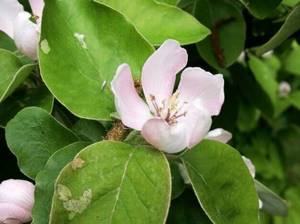
2.11.Watering
It tolerates both drought and wet soil quite well, but it is best to ensure proper, deep watering.
2.12.Purpose
The plant is a tapeworm and can be used as a hedge, also often as a dwarf rootstock for pears and some other fruits.
↑ Up,

Diseases and pests of Chaenomeles
Quince disease is a rare phenomenon. This happens in extreme cases when the plant is poorly cared for or is affected by a natural disaster, for example, the appearance of fungi in rainy times, necrosis and spotting. During such a period, the tree is very vulnerable to many diseases. They are combated using copper-based antifungal agents.

Before using chemicals, leaves and branches affected by the fungus must be cut off and burned. Spider mites and scale insects are the main enemies of Japanese quince. By following simple steps, you can prevent the appearance of pests, since getting rid of them is quite problematic. Spraying is carried out with special acaricidal preparations. The first treatment with solutions is carried out before the buds open; if you are lucky, a second treatment will not be needed.
Growing quince in the country
How to grow a quince tree in a summer cottage in order to get its magnificent fruits in large quantities? What growing conditions must be provided for the plant in order for it to please us with thick foliage and a good harvest? These questions are answered by dacha specialists, whom we turned to for advice.
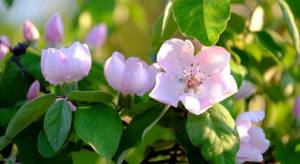
Soil preparation
Before planting seedlings in the ground, the soil must be properly prepared. To do this, you need to apply mineral fertilizers - 15-20 g of potassium salt and 45-50 g of superphosphate per 1 m2 of planting. After applying fertilizers, the soil must be dug up and left in this state for several days, lightly watering it with water.
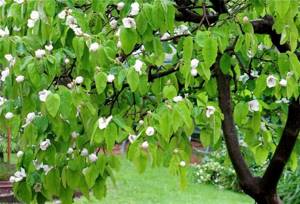
Next, preparation of holes for planting is required. They dig them to a depth of 35-40 cm and a diameter of 45-60 cm. A layer of clay is placed at the bottom of the hole, especially if you are going to grow quince on sandy or sandy loam soil. Fertilizers, well mixed with the soil, are placed on the clay layer, approximately 1/3 of the remaining depth - 50 g of wood ash and 150 g of superphosphate.
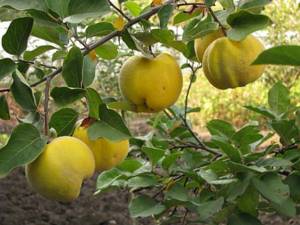
Photo gallery
Planting seedlings
We install seedlings in the prepared holes for planting, fill them with soil and tamp the soil a little. After planting, plants need light watering to help the fertilizer dissolve and stimulate the growth of the young tree.
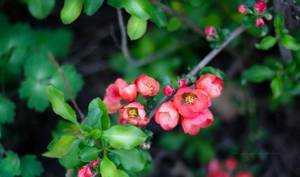
It is most correct to plant quince on the site in spring or autumn.
Plant care
First of all, try to prevent weeds in the tree trunks of a young tree, which will draw nutrients from the soil, remove them in time, and loosen the soil a little to increase aeration.
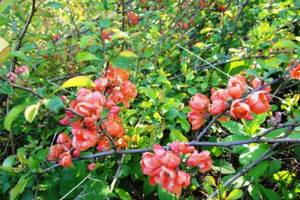
Watering is done several times during the warm season, but do not forget to water the trees generously during the growing season and fruit set. When the fruits are full, watering can be stopped, since the plant should have enough natural moisture (unless, of course, the summer is too hot and dry).
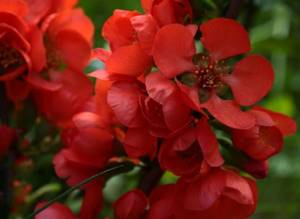
Quince pruning
Constantly remove weak, limp leaves and branches, dry and diseased shoots from the tree, remove frozen and dead branches in the spring, because they will not give any benefit.
It would be much more correct to carry out full pruning every spring, removing all excess from the tree at a time when the branches are not filled with sap. You can also prune in late autumn, preparing the plant for the winter.

It is necessary not only to remove diseased and dry branches, but also to shape the crown of the tree so that it is convenient for you to harvest. You definitely don’t need branches that go inside the crown or vertically upward, since the former will interfere with the plant’s normal development, and you simply won’t be able to reach the latter.

Plant nutrition
Young trees require periodic feeding, and most of all the root system of the plant needs the consumption of mineral fertilizers.
In the spring, when the quince is pruned and the soil in the tree trunks is first loosened, you can add up to 50 g of nitrophoska per each, and in the fall, after harvesting, 20 g of potassium salt and superphosphate per square meter of soil. Organic fertilizers are needed by the plant a little less often, approximately once every two years, and they must be applied after autumn processing and harvesting.
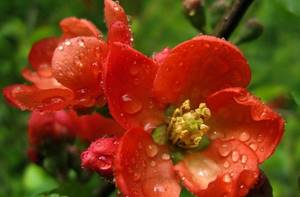
Preparing plants for winter
Preparing trees for the cold period is very important, because in severe frosts the tree can be damaged. Many varieties of quince that are grown in our dachas are winter-hardy, but they may not survive severe frosts. Protection from frost is quite simple - the trunks of young trees are wrapped in roofing felt at the end of October, and when snow falls, the trees are covered with it.

Useful properties of the plant
The fruits obtained from processing contain many essential substances such as vitamins C, B1, B2. The pectins contained in the fruit help remove heavy metal salts from the human body. Microelements of calcium, potassium, fluorine replenish reserves of nutritional minerals.
Juice is obtained from ripe fruits, which has an anti-inflammatory and immunomodulating effect, which cleanses the walls of blood vessels. Due to its specific sour taste, the plant was called “northern lemon”. With ailments such as anemia and exhaustion, quince fruits are considered excellent helpers, since they have a high iron content, exceeding the composition of pears and apples.
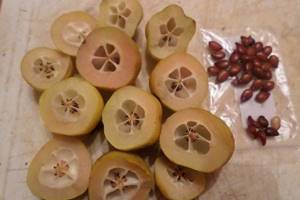
Quince fruits are used to stop bleeding, as a diuretic and antiemetic, and alcohol mixtures are infused, which have a general strengthening effect on the human body. In folk medicine it is used as a laxative or expectorant.
But Japanese quince has contraindications. They are a strong allergen, so it is not recommended to consume more than 1/4 of the fruit at one time. The pulp and tincture are contraindicated for stomach ulcers, since they contain a large amount of ascorbic acid, which corrodes tooth enamel, so after use it is necessary to brush your teeth or rinse your mouth well. The fluff from the peel of the fruit is harmful to the vocal cords, so it must be thoroughly cleaned.
